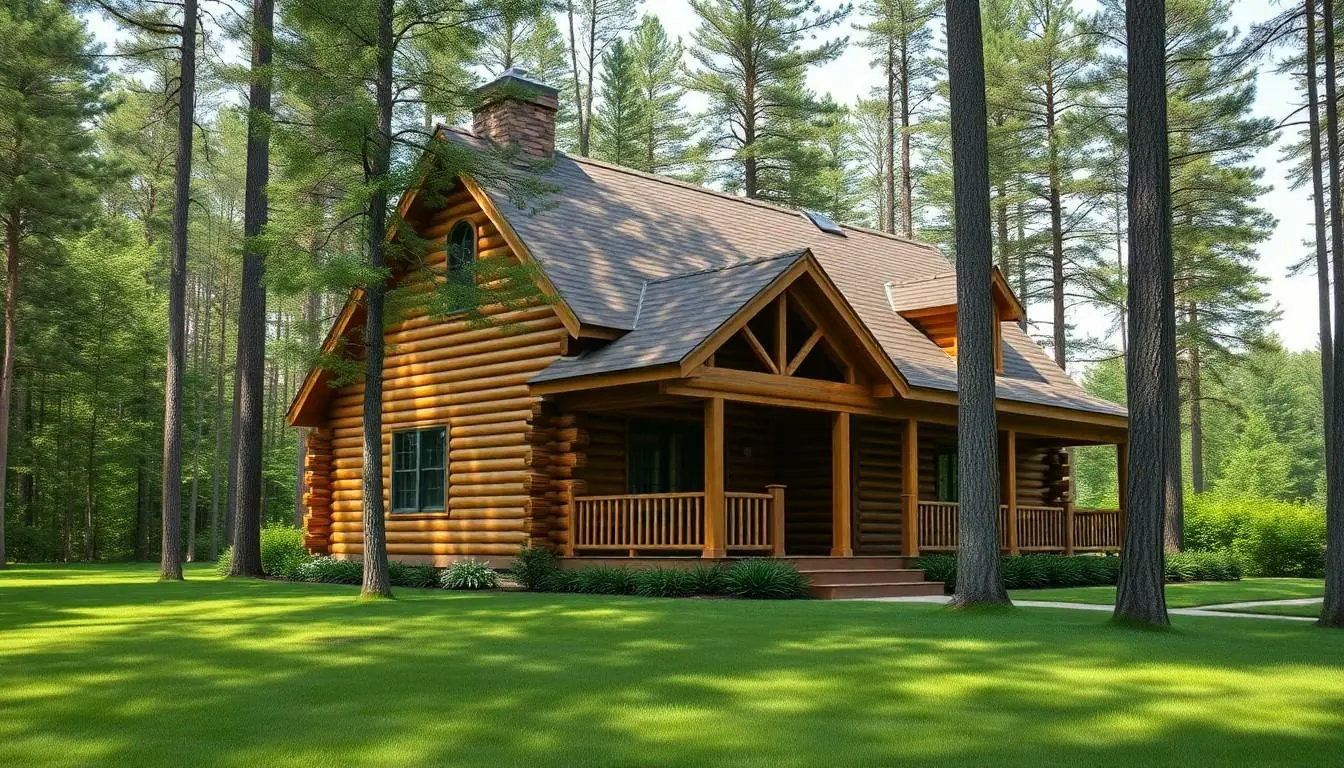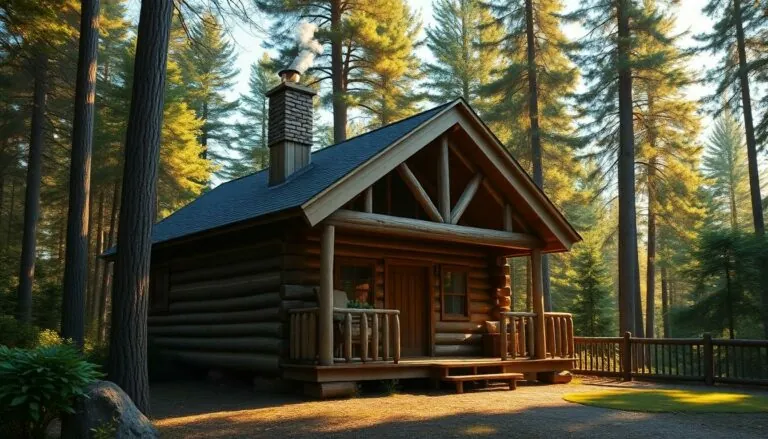Owning a log home is like living in a cozy woodland fairytale—complete with the charm of rustic aesthetics and the occasional squirrel trying to steal your lunch. But just like any enchanted forest, there are hidden dangers lurking around every corner. That’s where log home insurance swoops in like a knight in shining armor, ready to protect your slice of paradise from unexpected mishaps.
Table of Contents
ToggleUnderstanding Log Home Insurance
Log home insurance provides essential coverage specifically tailored for the unique needs of log home owners. This type of insurance addresses risks associated with log homes, offering peace of mind amidst the charm of woodland living.
What Is Log Home Insurance?
Log home insurance refers to a specialized insurance policy that protects against damage and liability related to log home structures. This policy typically covers perils like fire, theft, and natural disasters. It also encompasses personal belongings, additional living expenses, and liability claims if an injury occurs on the property. Coverage options may vary among insurers, emphasizing the need to assess individual circumstances and choose the right plan.
Why Is It Important?
Log home insurance plays a critical role in safeguarding an owner’s investment. High repair costs can result from damage to log homes due to their unique construction. Without proper insurance, homeowners might bear substantial financial burdens. Additionally, liability protection helps cover legal costs in case of accidents or injuries occurring on the premises. It’s vital for homeowners to protect their assets and ensure they can recover swiftly from unforeseen events.
Coverage Options for Log Homes

Log home insurance provides various coverage options tailored specifically to the needs of log home owners. Understanding these coverages helps ensure adequate protection against numerous risks.
Structural Coverage
Structural coverage protects the log home’s physical structure against events such as fire, storms, or vandalism. This policy component addresses repair or replacement costs due to damage incurred from unexpected incidents. Log homes require specialized materials and craftsmanship, often leading to higher repair expenses. Including structural coverage in the insurance policy ensures owners can restore their home without incurring significant financial burdens.
Personal Property Coverage
Personal property coverage safeguards belongings within the log home, including furniture, electronics, and valuables. This coverage extends to items damaged or destroyed by covered perils, such as theft or natural disasters. Knowing personal property limits helps owners protect their investments effectively. Many insurers offer options for increasing coverage amounts, ensuring that policyholders receive adequate compensation to replace lost or damaged items.
Liability Protection
Liability protection addresses claims arising from incidents on the property, covering medical expenses and legal fees resulting from injuries. This coverage proves essential for log homeowners hosting events or welcoming guests. Unexpected accidents can occur, highlighting the importance of financial security. Purchasing liability protection helps owners alleviate potential financial strains from lawsuits or medical claims, ensuring peace of mind in their property endeavors.
Factors Affecting Log Home Insurance Rates
Log home insurance rates depend on various factors. Understanding them helps homeowners secure appropriate coverage.
Location and Geography
Location significantly influences insurance rates. Homes in high-risk areas for natural disasters face higher premiums. Proximity to fire departments or emergency services can lower rates. Specific geographical features, like proximity to bodies of water, may also impact coverage costs. Insurers assess local crime rates; areas with higher incidents of theft often incur higher insurance costs.
Home Features and Construction
Log home features affect insurance pricing. The choice of materials plays a crucial role; log homes built with durable logs may attract lower rates. Roof type impacts rates as well; fire-resistant materials can lead to savings on premiums. Home safety features, such as security systems or fire alarms, also help mitigate costs. Furthermore, the age and condition of the home are considered; well-maintained homes typically qualify for lower rates.
Tips for Choosing the Right Log Home Insurance
Selecting appropriate log home insurance involves several key considerations that affect the protection level for the property. Start by determining required coverage, considering factors like the home’s value, location, and personal belongings. A thorough assessment of risks, such as potential natural disasters or local hazards, helps in tailoring a policy that meets specific needs.
Assessing Your Coverage Needs
Evaluate the home’s replacement cost to ensure adequate structural coverage. Consider personal property coverage to protect belongings against theft or damage. Liability protection plays a crucial role; it covers medical expenses and legal fees from accidents on the property. Review existing policies and add riders if specialized coverage is necessary. Heightening awareness of the local environment informs better decisions about coverage to address unique threats.
Comparing Insurance Providers
Research multiple insurance providers to find suitable policies for log homes. Examine customer reviews and claim handling experiences; these factors can indicate a provider’s reliability. Request quotes to compare costs and coverage options thoroughly. Ensure each policy’s terms align with specific log home requirements. Engaging with an insurance agent familiar with log homes provides valuable insights into the best available options. Prioritizing comprehensive coverage ensures maximum protection against unforeseen incidents.
Common Exclusions in Log Home Insurance Policies
Log home insurance policies contain several exclusions that homeowners should understand. Commonly, personal property damage caused by pests isn’t covered. Homeowners often overlook this exclusion, which can lead to unexpected expenses.
Natural disasters like floods and earthquakes often fall outside standard coverage. Specific riders or endorsements might be necessary to protect against these events. Many homeowners assume their policy covers all natural disasters, which can result in significant financial surprises.
Maintenance issues typically aren’t included in log home insurance policies. Problems arising from neglect, such as rot and deterioration, remain the owner’s responsibility. Standard coverage doesn’t address maintenance-related costs, highlighting the need for regular upkeep.
Wear and tear over time also doesn’t qualify for coverage. Insurers view normal deterioration as a homeowner’s responsibility rather than an insurable risk. Homeowners must plan for routine repairs and replacements to avoid unexpected expenses.
Lastly, liability for injuries that occur off the property usually isn’t covered. Owners might assume general liability extends beyond their premises, leading to confusion about their protection. Clear understanding of each type of liability is crucial for adequate coverage.
These exclusions emphasize the importance of reviewing policy terms carefully. Seeking advice from insurance professionals ensures comprehensive understanding. Empowering homeowners with knowledge about these exclusions can help in selecting the best policy for their log home insurance needs.
Log home insurance is essential for protecting the unique investment that comes with owning a log home. It not only covers the structure but also safeguards personal belongings and provides liability protection. Homeowners must carefully assess their coverage needs and understand the factors that influence insurance rates.
By comparing policies and consulting with knowledgeable agents, they can secure the best coverage tailored to their specific needs. Awareness of common exclusions is crucial for avoiding unexpected gaps in protection. With the right log home insurance, homeowners can enjoy their cozy retreats with peace of mind, knowing they’re prepared for whatever challenges may arise.



